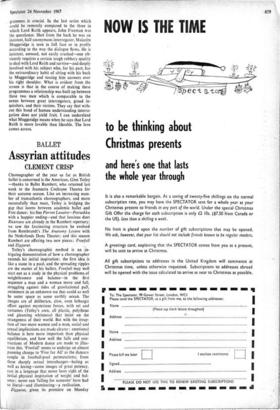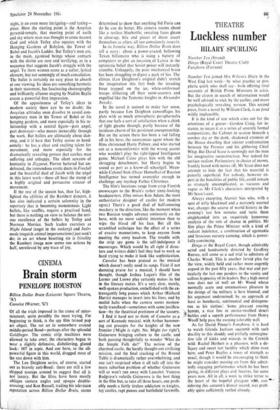Assyrian attitudes
BALLET CLEMENT CRISP
Choreographer of the year so far as British ballet is concerned is the American, Glen Tetley —thanks to Ballet Rambert, who returned last week to the Jeannetta Cochrane Theatre for their autumn season. Like an increasing num- ber of transatlantic choreographers, and more successfully than most, Tetley is bridging the gap that looms between academic ballet and Free dance: his fine Pierrot Lunaire—Petrushka with a happier ending—and that luscious duet Ricercare are already in the Rambert repertory; we saw the fascinating structure he evolved from Rembrandt's The Anatomy Lesson with the Nederlands Dans Theater; and this season Rambert are offering two new pieces: Freefall and Ziggurat. Choreographer of the year so far as British ballet is concerned is the American, Glen Tetley —thanks to Ballet Rambert, who returned last week to the Jeannetta Cochrane Theatre for their autumn season. Like an increasing num- ber of transatlantic choreographers, and more successfully than most, Tetley is bridging the gap that looms between academic ballet and Free dance: his fine Pierrot Lunaire—Petrushka with a happier ending—and that luscious duet Ricercare are already in the Rambert repertory; we saw the fascinating structure he evolved from Rembrandt's The Anatomy Lesson with the Nederlands Dans Theater; and this season Rambert are offering two new pieces: Freefall and Ziggurat.
Tetley's choreographic method is an in- triguing demonstration of how a choreographer extends his initial inspiration : the first idea is like a stone in a pool, and the spreading ripples are the matter of his ballets. Freefall may well start out as a study in the physical problems of weightlessness and balance—in the first sequence a man and a woman move and fall, struggling against tides of gravitational pull, swimmers in an unknown sea that could as well be outer space as some earthly ocean. The images are of deliberate, slow, even lethargic effort against mysterious forces, with set and costumes (Tetley's own, all plastic, polythene and gleaming whiteness) that insist on the strangeness of their world. But with the irrup- tion of two more women and a man, social and sexual implications are made clearer : emotional balance is here more important than physical equilibrium, and how well the falls and con- tractions of Modern dance are made to illus- trate this. `Freefall' seems to undergo an almost punning change to 'Free for All' as the dancers couple in football-pool permutations; from these sharply sexual interchanges—hating as well as loving—come images of great potency, cast in a language that never loses sight of the initial physical inspiration of weight and bal- ance: never can 'falling for someone' have had so literal—and illuminating—a realisation.
Ziggurat, given. its premiere on Monday night, is an even more intriguing—and taxing— piece. Here the starting point is the Assyrian pyramid-temple, that meeting point of earth and sky where man was thought to come nearest God and which Tetley also equates with the Hanging Gardens of Babylon, the Tower of Babel and Jacob's Ladder. But Tetley's men are, in the main, agonised beings whose contacts with the divine are rare and terrifying, as in a sequence that suggests Jacob's struggle with the angel. To them women come as a softer, lyrical element, but not seemingly of much consolation. The ballet is certainly no easy piece to absorb at one viewing. Its ideas are something hermetic in their statement, but fascinating choreography and brilliantly allusive staging by Nadine Baylis create a powerful first impression.
Of the appositeness of Tetley's ideas to modern society there can be no doubt; the Assyrian attitudes soon dissolve to reveal con- temporary man in his Tower of Babel or his hanging gardens, and more especially in his re- lationship with a central figure—part angel, part destroyer—who moves inexorably through the work. But ballets are ultimately about dan- cing, and it is' here that Tetley scores so hand- somely : he has a clear and exciting talent for movement, and more especially for the dramatically revealing gesture that catches man suffering and unhappy. The silent screams of humanity in Ziggurat, Pierrot battered but un- defeated, the tremendous erotic duets in Freefall and the beautiful duel of Jacob with the angel in this latest work—these all bear the stamp of a highly original and persuasive creator of movement.
If the rest of the season has, thus far, high- lighted the abilities of the Rambert dancers, it has also indicated a certain solemnity in the repertory that is becoming monotonous. Light ballets, like souffles, require a practised hand, but there is nothing on view to balance the seri- ous excellence of the ballets by Tetley and Norman Morrice. Such leaden exercises as Night Island (angst in the rockery) and Inter- mede (roguish animal impersonations) just won't do; in an art whose besetting sin is frivolity the Rambert image now seems too serious by half, unrelieved by any trace of joy.















































 Previous page
Previous page